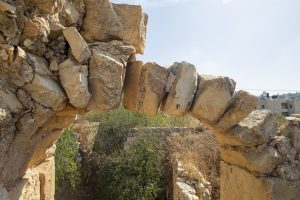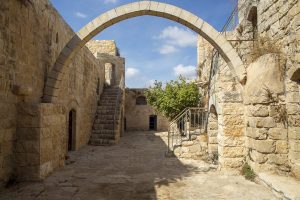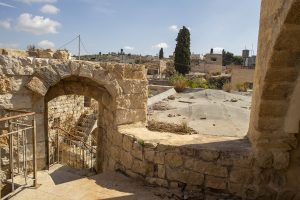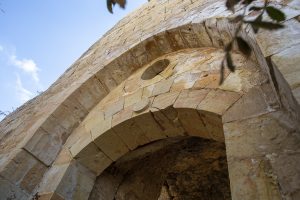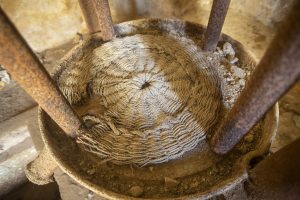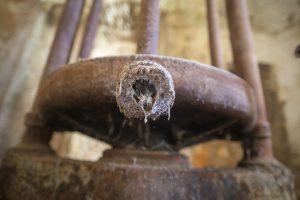In the middle of the village lies a clean, recently renovated piazza called As-Saha that contains a large fortified Ottoman-style building. A quiet neighborhood attracts visitors to explore the five-acre old town of Mazari al-Nubani, a village located in the heart of the middle mountain range of Palestine, rising 510 meters above the Mediterranean Sea. (Lat.: 32.04919833, Long.: 35.16583333)
Today, when I pass by the village, I recall the famous Jordanian actor, Zuhair al-Nubani, whose family originates from this village, with his sinister roles in Bedouin Jordanian sitcoms that used to fill our TV screens in the 1980s.
During the Ottoman period, the village was known as Mezra’a (farm), but to differentiate it from other villages in the area with the same name, people named it Mazari al-Nubani after Sheikh Saleh Al-Nubani, a holy Sufi sheikh whose maqam (shrine) lies in the center of the town. The well-cleaned three-room shrine with very low doors resembles that of the Church of the Nativity. The first prayer room is a three-by-three-meter room that contains a small grave with a round headstone. The other room, similar in size, houses two large graves believed to be those of Sheikh Saleh and his son. Some 300 years old, the headstones carry inscriptions that are difficult to decipher.
Mazari al-Nubani is known to be one of the Sufi villages in the area. In Biladuna Filastin, Mustafa Dabbagh writes about another Sufi clan named Dhamra, going back to the Bani Dhamra clan of Adnan, the tribe in Hijaz from which Prophet Mohammed descends. The Dhamra clan also has a zawiya in the village built by Sheikh Yaseen Dhamra, dating back to 1183 AH (1769 AD). The zawiya courtyard contains very old graves, some 400 years old, mixed with new “residents” from the last century. Both zawiyas have rooms for inscriptions and a library where Sufi prayers used to be held.
Opposite the Dhamra maqam is the Dhamra complex, dating back to 1050 AH (1640 AD), which was built by Sheikh Ismail Dhamra. The two-floor complex is rectangular in shape, and its open courtyard in the middle hosts a delicious orphan Guava tree. Not so long ago, the complex was home to several families and bustling with life. Ahmad Alnoubani, professor of geography at Birzeit University, recalls the sounds of prayers that used to be held in these shrines way back when…
The old town of Mazari al-Nubani took its share of the fires of World War I. A small Ottoman garrison was stationed in a modest fortified castle owned by the Helo family in the middle of the town, when the structure was hit by a mortar shell from the opposite hill of Nabi Saleh where British artillery was positioned. The castle still stands with its top room destroyed as a witness to the time of war.
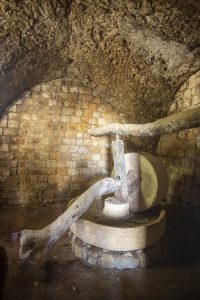
On the northern side of the small old-town street, Professor Alnoubani holds the key to the oldest-standing olive press. Carefully, he opens the door to a one-hundred-year-old two-room olive press, with its hydraulic machine in the first room and a mule-driven grindstone still in shape in the second room. Standing the test of time, the press testifies to the romantic past we all lament.
For more information and guidance, please contact Dr. Ahmad Alnoubani at 059 590 9570 or write him at aalnoubani@birzeit.edu.
Bassam Almohor can be reached at almohor@gmail.com, 059 753 4681, or through Facebook: @palestinestreetlife.

